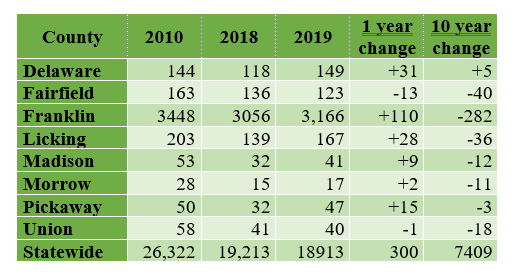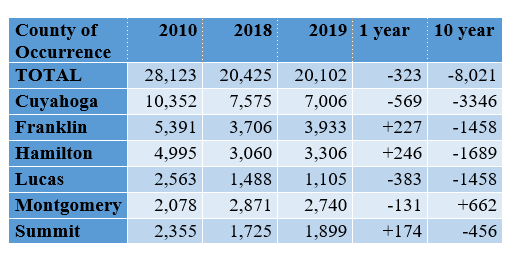2019 Ohio Abortion Statistics Released
Ohio Abortion numbers
In 2018, Ohio abortions dropped by 468 procedures statewide, from 20,893 abortions in 2017 to 20,425 in 2018. Last year, Ohio abortions dropped by 323 procedures statewide from 20,425 to 20,102. This means that last year, just over 55 babies died each day from abortion in Ohio. Statewide, about 39% of all abortions were conducted non-surgically, most by the abortion pill. Once again, most abortions were performed in an ambulatory surgical facility (18,707), while 1,356 were performed in a non-surgical clinic, and 39 were performed in a hospital. Statewide, the largest number of abortions were performed on women ages 25-29, and once again African American women were disproportionately likely to have an abortion. Among Ohioans who reported their race, white women made up 46.1% of all abortions, black women made up 45.9%, and American Indian, Pacific Islander, and multi-racial made up .3%, 3.6%, and 4.1%. Eighty-two percent of women having an abortion report being not married (single, separated, divorced, or widowed). About 10.5% were married, and 7% did not report their marital status. Ninety-five abortions were reported as being performed after 21 weeks of gestation. Approximately 6% reported Hispanic ethnicity.
Local abortion numbers
Ohio measures abortion statistics in two ways. One is by the total number performed in the county and one is by the number of abortions performed on women living in a county. In Ohio, known abortion clinics exist in only a few counties: Franklin (2), Cuyahoga (2), Lucas (1), Summit (1), Montgomery (1), and Hamilton (1). Each year, a few abortions are generally reported outside of those settings. We generally presume that those occur in a hospital setting, but we cannot know for sure. As pro-life people, our goal is not only to see the total number of abortions decline, but also the number of abortions occurring in our community and the number performed on women living in our communities. In last year’s statistics, we had about six months with two abortion clinics that performed surgical and medication abortions, about a month where only one clinic was open that performed surgical and medication abortions, about two and a half months when one dual and one medication-only clinic was open, and about two and a half months when one dual and two medication only clinics were open. In 2019, the statistics reflect having all three clinics open: one offering both types of abortions and two offering medication only. Thus, while it is a disappointment, it is not a surprise that abortions slightly increased in central Ohio. In addition, we tend to see fairly cyclical process of large drops over a few years and then a small increase. There are two ways to end abortion: the demand side and the supply side, and we need to work on both.
Looking at the counties that make up the GCRTL area, we saw two counties (Fairfield and Union) with decreases and six with increases (Delaware, Franklin, Licking, Madison, Morrow, and Pickaway). However, we always remind our communities that this is just a snapshot of one statistic, and it does not reflect the whole picture of what we see in the community. Many areas of central Ohio are growing at a rapid pace, and year-to-year numbers can fluctuate quite significantly. Part of the reason that we look at these numbers is to know where to suggest programs and projects. In the next few months, we will be updating our abortion rate project which looks at abortion compared to population and live births. That said, we’ve got a lot of work ahead of us.


 RSS Feed
RSS Feed
